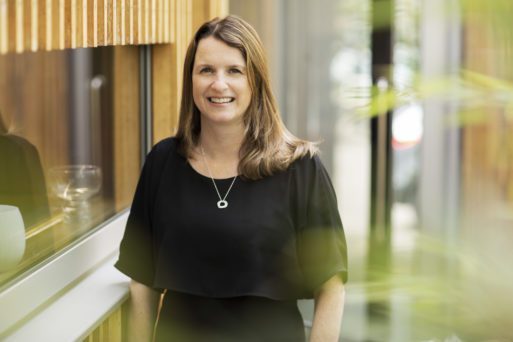
Ann-Louise Ward, the Chief Operating Officer of Maggie’s
Credit: Philip Durrant
What happens when an artist is confronted with a problem? Often, the artists look for creative ways to deal with the issue. When writer and garden designer Maggie Keswick Jencks was confronted with a cancer diagnosis in the early 1990s, she quickly realized the impact of being in healthcare centers so often. The dull, sterile surroundings of hospitals took a toll on her mental health. Keswick Jencks tackled this trouble by returning to her artistic roots.
Comprehensive, Person-Centered Cancer Care Maggie’s (formerly Maggie’s Centres) holds a special place in many Britons’ hearts. Founded in 1995 by Keswick Jencks and her landscape designer husband Charles Jencks, Maggie’s are unique cancer sites adjacent to hospitals that deliver individualized wellness care to patients as well as support for their loved ones.
The healing power of architecture and beautiful surroundings has been astounding. Arriving at one of these thoughtfully designed centers, where the environment has been specially crafted to be visually appealing and soothing, can bring joy and comfort to cancer patients all over the UK and Hong Kong.
Today SevenPonds sat down with Maggie’s Chief Operating Officer Ann-Louise Ward. Having spent most of her career in healthcare, Ann-Louise held various leadership roles at Maggie’s in London before becoming its COO in 2015.
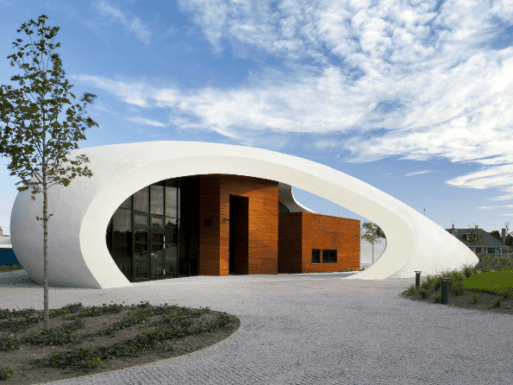
Maggie’s Centre, Aberdeen, Scotland. The building was designed by Snøhetta and built in 2013. Designed in the shape of a pebble, it offers warmth and comfort to its visitors.
Editor’s note: This interview has been edited for length and clarity.
I love the story of how Maggie Keswick Jencks saw an unused stable block on the Edinburgh hospital grounds and persuaded the National Health Service to convert it. Could you tell me a little more about the origin story of this charity?
Of course. Maggie Keswick Jencks was diagnosed with breast cancer in 1989 and it returned in 1993. She used her own experience of living with cancer to create a new type of care, and that’s what we see today.
She strongly believed that, with the right support, no one should lose the joy of living in the fear of dying, and that’s her own words. It was really important to her.
I never met Maggie myself. Dame Laura Lee, who’s our chief executive, was her oncology nurse and obviously knew her well. But Maggie described really vividly in her booklet “View From the Front Line” how, after she was given her diagnosis, she was moved into the corridor of a hospital. And then the doctor had to leave her because there were lots of other people to be seen.
She really wanted for others not to have to experience the same thing, that they would have somewhere to turn, somewhere that they could meet other people who are in similar circumstances. What was particularly important for her was creating a somewhere that welcomed children and where her husband could go for support — not just now but in the future.
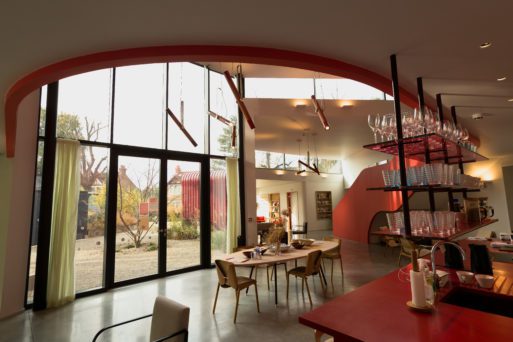
A look at the interior of Maggie’s at Royal Marsden, which was designed by Ab Rogers Design in 2019. Ab Rogers Design created this space to be a vibrant environment, which engages the senses and improves quality of life.
I understand that architecture is an important part of the design of Maggie’s, which includes the works of Zaha Hadid, Frank Gehry, and Daniel Libeskind. Would you mind talking about how architecture lends itself to healing (or the opposite)?
We all have experienced it, being in an architectural space, or with a design that lifts you up, makes you feel good. You can walk into somewhere and think, “Oh, I instantly feel better as a result of coming in here.”
Our centers are designed to be non-institutional, so they are in contrast to what you’d see in a hospital environment. Hospitals are designed in a particular way; the clinical environments are necessary for medical professionals to do their work. But what Maggie envisaged was a space that was warm and welcoming and friendly. Something that was different from the hospital, somewhere where you could come in and be at ease and be able to talk about things that you wouldn’t necessarily have the time or feel able to talk about with a doctor or within a hospital environment.
A visible shift happens when people walk through the door. You almost see people’s shoulders sort of instantly be put at ease as a result of coming into these spaces. They are really special places. What’s fantastic and brilliant about this architecture and design is that they tell people that they really matter.
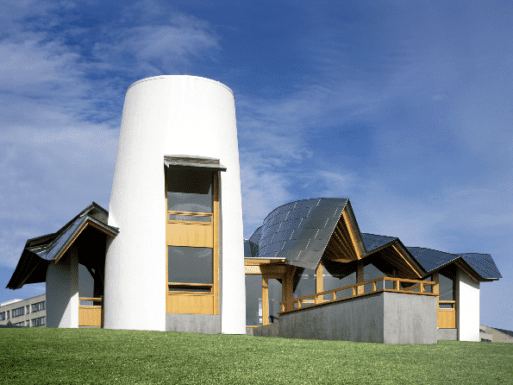
Maggie’s Centre, Dundee, United Kingdom. Built in 2003 by Frank Gehry, this centre is modeled after a “butt ‘n ben” dwelling. It offers a sense of calm and sanctuary.
I understand that Maggie’s is an independent charity. Does that mean that it’s all donation-based?
Predominantly, we’re obviously based on NHS hospital sites, but in terms of the generation of the revenue to continue to run the organization and to grow it, yes, it’s all donations-based.
Because everything we provide is free for the person who comes in the door at Maggie’s, we don’t charge anything; it’s not time-limited at all. So, people who are coming in can access us as much as they like. But again, we have to generate that income from the community. So, in many ways, there’s that reciprocity often, where people will come in, and when they’re finished their care treatment, and they go on to live their lives, often that’s when they’ll come and give back to Maggie’s. But we don’t ask for anything from our visitors.
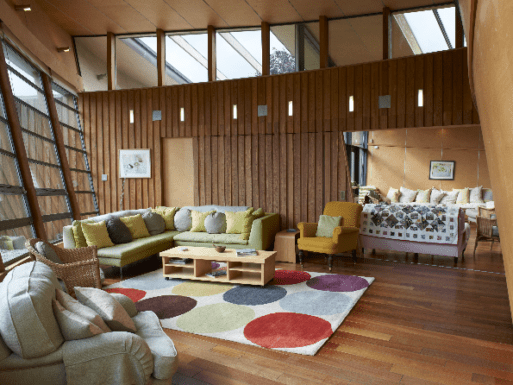
Maggie’s Centre Highlands, Inverness, Scotland. The Highlands centre and its garden were co-designed by architect David Page and founder Charles Jencks in 2005. Bringing in a great deal of light was the goal in order to provide patients with warmth and nurture.
Could you tell us a little bit about the care patients receive?
From a care perspective, we support people across the whole cancer experience, right from diagnosis all the way to end of life as well as the family and friends of people with cancer.
You can see a psychologist when you come in, and we’ve got nutritional support. We’ve got programs that support you right at the beginning of your cancer treatment, survivorship programs and those particular to end of life.
We do networking for cancer-specific support groups as well as more facilities-themed groups. We have groups for young women; for men, we have prostate cancer groups and lots of different things. It’s a really integrated program. What’s really important is that there’s no one-size-fits-all at Maggie’s.
We tailor that program to your individual needs. For everybody who comes through the door, their needs are individual to them and unique to them. We work with you as an individual to make sure that we shape and tailor that program so that it’s right for you
It’s about responding to the needs of the cancer community and understanding people and what might be best for them. Everything we do is evidence-based.
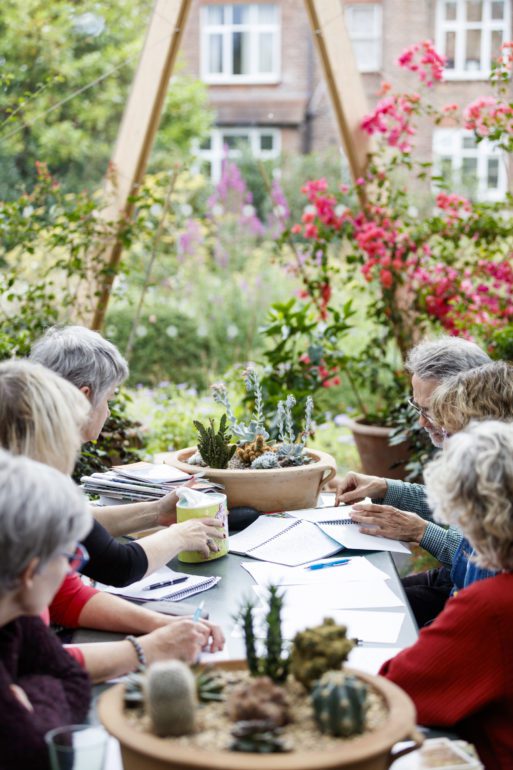
At Maggie’s Manchester (opened in 2016), patients put pen to paper and create. Lord Norman Foster, who designed this centre, shares, “This project has a particular personal significance, as I was born in the city and have first-hand experience of the distress of a cancer diagnosis. I believe in the power of architecture to lift the spirits and help in the process of therapy.”
Is there one benefit that most patients seek above all others?
Because people are people, and they come in as people, and we support them with their individual needs. I wouldn’t say there’s one individual benefit. People come in for all sorts of reasons, all different stages of…or different parts…or place in their experience, really. As I say, some come in because of financial worries, some come in because of emotional worries, some come in for family.
Because cancer keeps changing, you are someone with a cancer diagnosis, Maggie’s will respond to what your needs are when you come in.
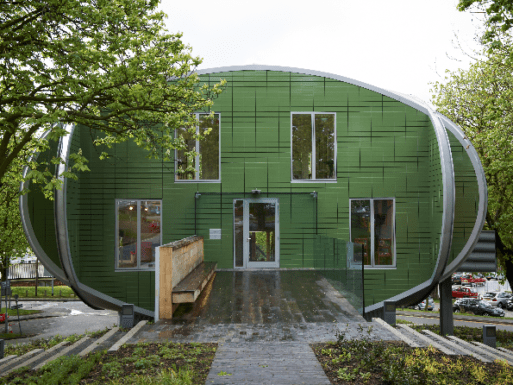
Maggie’s Centre, Nottingham, United Kingdom. Built in 2011, this Piers Gough designed building almost appears to float in the trees and offers visitors a sense of symmetry and balance.
Could you share a story about a person who found the needed support at Maggie’s?
One is a man called Colton; his wife was diagnosed with ovarian cancer. They had, or have, a daughter called Saffron. They were living across from where the Maggie’s Centre was being built…Sadly, Amanda died 12 months before the center opened, so she wasn’t able to use it.
But there was some way that, had they been able to go in together, they would have gone in as a family. Before Amanda died, they talked a lot about how were they going to have the conversation to support the daughter through this experience.
Colton went to Maggie’s after Amanda died to talk to one of our psychologists. He was having real difficulty. He just couldn’t see how he could find a way out of feeling so upset and so devastated. He knew that he had this young daughter, who was going to become a teenager, and he worried about how was he going to play the role of Mum in that situation.
He met with our psychologist, Emma, and she spent a bit of time talking to him through the situation. He described a sense of calmness being restored, being able to breathe again. What was really great about it was that he had a wonderful bond with his daughter. He suddenly understood how he might talk to his daughter about some of the things that he described as being best dealt with by a woman.
He’s much more accepting now about how he’s feeling, and he’s now got the confidence to talk about the personal stuff that Amanda would have done. For Saffron, she’s okay now that her dad’s asking these questions.
It was really amazing for him. He just wishes that his wife had been able to get the support that she needed during her cancer treatment at the time from the center.
Colton describes Maggie’s as being a lifeline that was able to help him through his darkest days. For him, being able to properly look after and support his daughter through her teenage years has been really important for him.
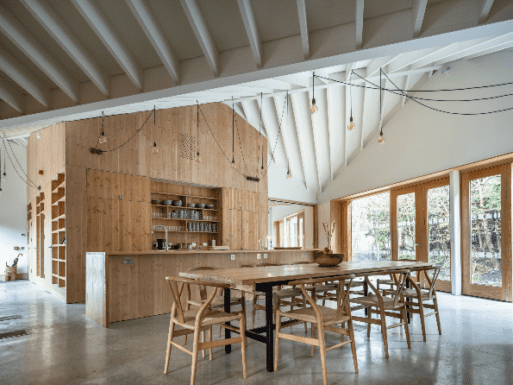
Maggie’s Centre, Cardiff, United Kingdom, was opened in 2019. Designed by Dow Jones Architects, this centre offers intimate, contemplative spaces.
Do you see Maggie’s model being possible in the U.S.? If so, what advice would you give to an organization trying to implement this model here?
We’re often asked about the U.S., interestingly. If you go back to Maggie, when she was looking at the whole concept and the idea and a blueprint, she went to the U.S. and she went to the wellness community in Santa Maria. One of the things that they shared with her was about remaining independent of the hospitals and maintaining independence. And that actually still is true today. So, whilst we are still built at hospital sites, we are independent of the hospital and everything about what we do is complementary to the care that we provide. But for her, that was a really important part of looking at it.
There might be some cultural differences in the way that things are delivered in Hong Kong. But the underlying or the overarching program is the same because it’s based on people’s information needs and emotional needs, the practical needs and social needs.
And therefore, it could be applied. It can be flexed and bent and fluid, as long as it continues to meet those needs that people are presenting with.
If you had one piece of advice for someone with cancer who is in need of support, what would it be?
There’s no right or wrong way to do things. You need to find out what works for you and your loved ones, and not let anyone else tell you what’s right for you. And that there are people who can help and organizations like Maggie’s. It’s really about how we can help you to find your own way through cancer rather than someone telling you how to go about doing it.

 Maggie’s Cancer Centers: Why Architecture Matters in Healthcare
Maggie’s Cancer Centers: Why Architecture Matters in Healthcare


 How Dare You Die Now!
How Dare You Die Now!
 Debating Medical Aid in Dying
Debating Medical Aid in Dying
 “Help Me, Helen”
“Help Me, Helen”














